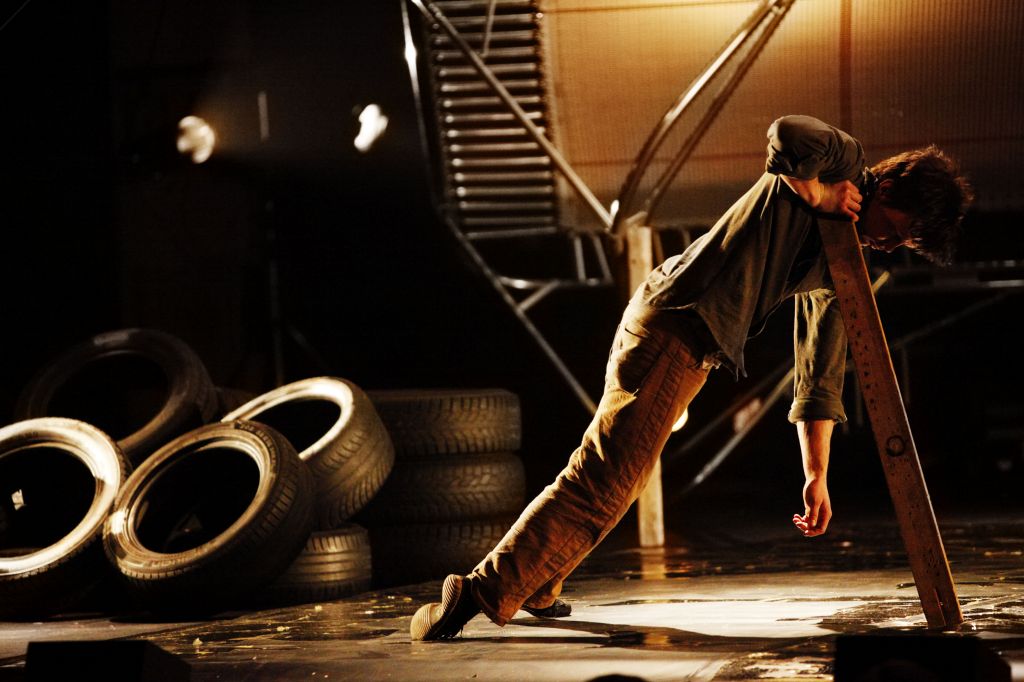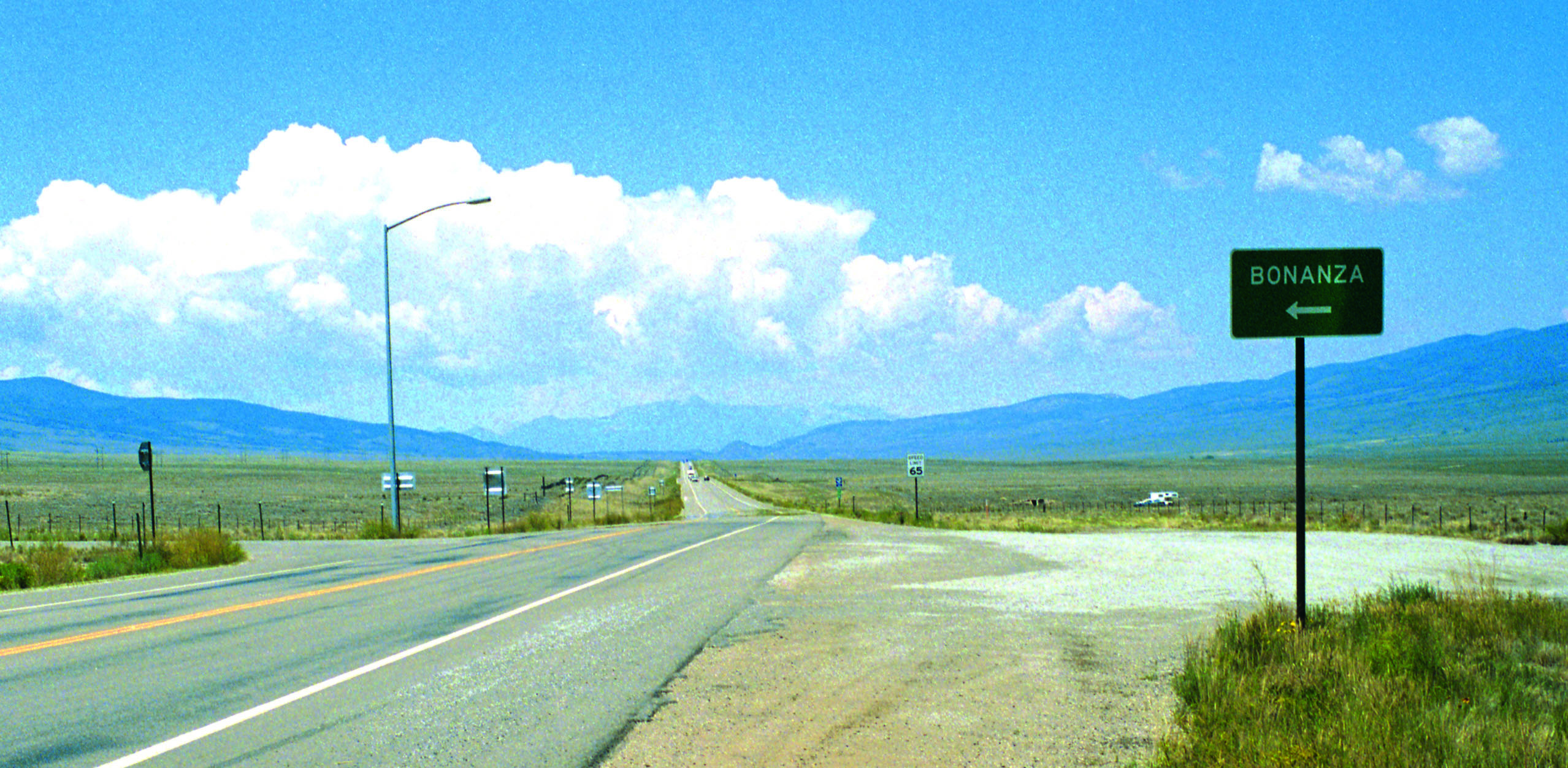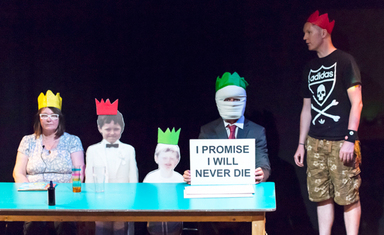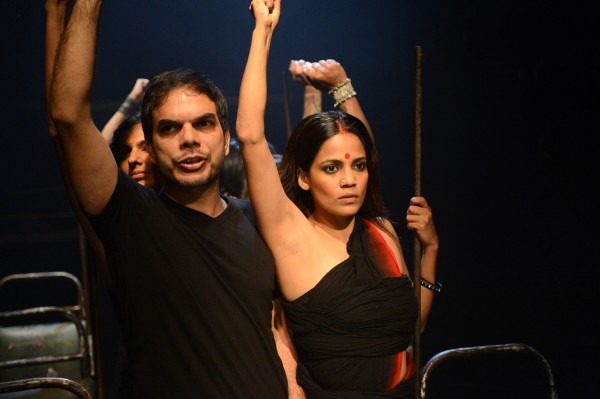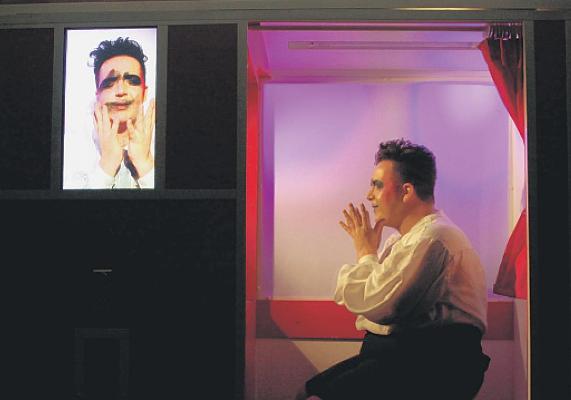
Dorothy Max Prior on the Total Theatre Awards winners and nominees
So that’s it – the Edinburgh Festival Fringe is done and dusted. Shows have ended, Awards have been given, and the colourful Brigadoon city (purple cows! red-and-gold Spiegeltents! lime-green Astroturf!) has melted into the mist, leaving behind the stern grey brick of all those kirks and castles, and the quiet and shadowy cobbled alleyways and staircases that Robert Louis Stevenson’s Mr Hyde scurried down after dark.
This year’s Fringe saw a fantastic number of top quality circus shows, and this was reflected in the Total Theatre Awards nominees list, which included no less than six circus or circus-related shows: NoFit State’s Bianco, Circa’s Wunderkammer, Pirates of the Carabina’s Flown, Compagnie Bal’s La Poème, Gandini Juggling’s Smashed, and Stefan Sing & Cristiana Casadio’s Tangram. All of those shows have been reviewed over the three weeks of Fringe 2013, or honoured in Adrian Berry’s circus round-up. This strong representation yielded results, as we had not one but two circus winners of Total Theatre Awards 2013: Flown by Pirates of the Carabina (from the UK, presented by Crying Out Loud at Underbelly) won in the Total Theatre Awards Physical and Visual category, and Australian company Circa received a special Significant Contribution Award in honour not only of Wunderkammer (presented in Edinburgh this year), but of all their other magnificent work over the past two decades, which we feel it is fair to say has changed the landscape of contemporary circus.
Crying Out Loud, one of the most enterprising producing companies in the UK, had a double success in the Physical/Visual category as they also presented Compagnie Non Nova from France, who won with L’Apres-midi d’un Foehn (known to all who have seen it as the lovely plastic bag show). It is a stunningly simple idea that works beautifully: a circle of fans create an airstream that animates an ensemble of different coloured plastic bags, cut and tied so that they inflate into tiny dancing humanoid shapes. If you didn’t see it in Edinburgh and your curiosity is piqued, note that another version of the show (the ‘adult’ version, apparently) will be presented at the London International Mime Festival 2014 (opening 8 January).
So two great winners, but the rest of the nominees were a pretty amazing bunch – and an interesting international mix. Yet another Crying Out Loud show made the shortlist, Compagnie Bal’s La Poème (like Compagnie Non Nova, presented at Summerhall venue), featuring the highly talented circus artist Jeanne Mordoj, using her contortion and manipulation skills to create something unique. As our review says, ‘What a pleasure and an honour to see a performer in such control of her body, and of the imaginary world that she has created on a bare stage, armed with little more than a box of eggs, a harmonium, and a pretty green silk skirt.’
Work by women performers/choreographers from across Europe featured heavily in the nominations list. Not only Jeanne Mordoj from France, but also Markéta Vacovská from the Czech Republic (One Step Before the Fall), and Scotland’s own Claire Cunningham (Ménage à Trois).
One Step Before the Fall, presented by Spitfire Company and Damúza Theater at Zoo, is a collaboration between dancer/choreographer Markéta Vacovská and singer/multi-instrumentalist Lenka Dusilová. Together these two wonderfully talented women create an extraordinary live play between sound and physical action in a piece that is an exploration of (and homage to) Muhammed Ali’s boxing life. In this intensive piece Markéta Vacovská captures the trance-like concentration, energy and focus of the boxer – not through acting but by being. Pushing and pushing herself further and further, she becomes pure, archetypal male energy, and for 45 minutes (I doubt if she could possibly keep the energy up for any longer) works through a moving meditation that, whilst containing little in the way of conventional narrative, nevertheless tells a thousand stories. The live sound (haunting vocals, looped electric guitar, percussion, sampled sounds) is mixed with broadcast recordings of Ali’s voice from the later years when Parkinson’s disease had set in. There is no preaching, no conclusions drawn – the audience are left to form their own views on whether this was a sacrifice worth making. I’ve seen a good few shows about boxing – and I’ve even helped to make one – but this is the best by a long shot. The passion, the desperation, the drive, the joy, the weariness, the pain – it’s all here, an exploration of what it means to be a boxer unencumbered by the usual clichéd storylines.
Ménage à Trois, presented by National Theatre of Scotland at Paterson’s Land, is a dance-theatre piece created by performer/choreographer Claire Cunningham (who is joined onstage by Christopher Owen) and co-director/video designer Gail Sneddon. It’s a visually beautiful piece, well staged. The set design – oversized pieces of dark wood furniture – give a kind of Alice-in-Wonderland feel to the piece, and the animated monochrome line drawings of the video projection are lovely, and well integrated into the show. Cunningham’s choreographic approach is ‘rooted in the use/misuse, study and distortion of crutches’ which here appear in many different guises and forms: suspended from the ceiling as objets d’art; sculpted into Oskar Schlemmer style multi-material dresses; ‘puppeteered’ as dance partners or dream lovers. Owen arrives well into the piece, as the dream lover or companion conjured by Cunningham. There are some stunning images created, but the piece sinks a little in the middle, and is also held back by the text which is hammered home by appearing both in the soundscape and as part of the visual landscape. The soundscape generally could be stronger, but there is one absolutely gorgeous moment when Claire Cunningham sings Mozart’s ‘Deh Vieni Non Tardar’ live – a magic moment.
Also in the Physical and Visual nominees list was Abattoir Fermé’s Tourniquet, one of five shows presented at the Ed Fringe 2013 under the auspices of the Big in Belgium programme of Flemish theatre. Tourniquet is a word-free piece that presents a nightmarish vision, albeit in such a stylised and almost cartoonish mode that it never transgresses into threat. The piece was inspired by clandestine exorcisms that are still performed throughput Europe, and features three ghosts or devils hanging on for grim life (or death). Our gruesome threesome walk an endless treadmill of rituals and compulsive actions. They seem to die a thousand times, never able to leave their self-created limbo. It’s like a cross between early La Fura dels Baus, The Addams Family, and The Night Porter. The images are ostensibly shocking, but there’s a kind of tongue-in-cheek punk knowingness and devilish humour about it all that strips it of any real shock value. Instead, we seem to be looking at a series of beautifully sculpted tableau representing a contemporary view of hell (or perhaps they are trying to purge themselves in purgatory): a naked pale-as-the-moon woman ‘crucified’ on a wooden beam, a big broad bare-buttocked man in a white rubber apron and butcher’s gloves advancing ominously, an unfurled Nazi flag, a Twin Peaks-like lonesome guitar twang, laboured heavy breathing, a constantly repeating TV clip of an American preacher screeching ‘in the name of Jesus I find you, Devil’, a deconstructed rendering of ‘Dream a Little Dream of Me’, and a body drowned in a bath (the puddles are there for us to avoid as we leave at the end) then wrapped in cellophane. All of this washed down by an endless amount of blood red wine… It’s not a show I could say I truly enjoyed, but it’s one that has stayed with me.
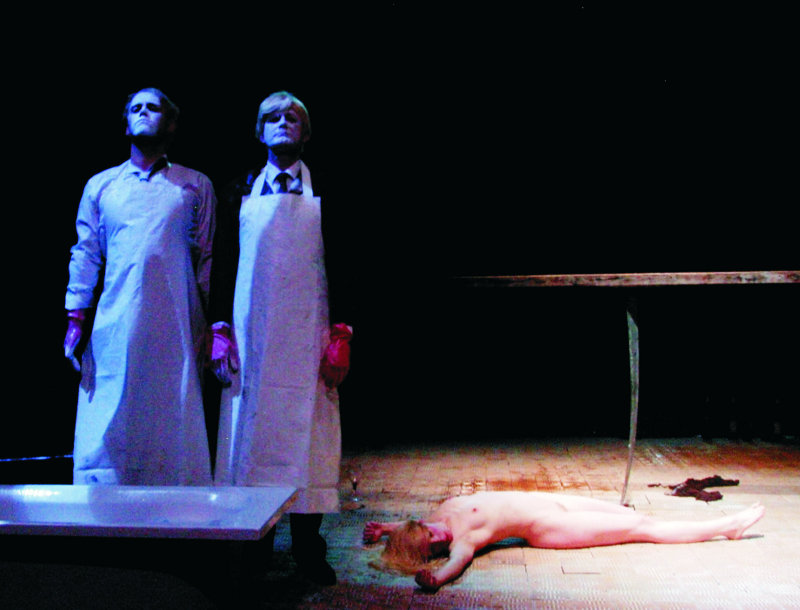
Abattoir Fermé, Tourniquet | Photo: Stef Lernous
Also part of the Big in Belgium programme were two other Awards nominated shows: Freeze, by Nick Steur, (shortlisted in the Emerging Artist category); and Bonanza by Berlin (who confusingly come from Belgium not Germany) – a piece with no live performers that caused consternation amongst some critics. Bonanza went on to win a Total Theatre Award for Innovation.
The second winner in this category was The Worst of Scottee, by cabaret artist Scottee, who is mostly known through his work with Duckie. But this show was something else altogether. Directed by the always enterprising and interesting Chris Goode, The Worst of Scottee wove together his bouffon-camp cabaret turns with confessional-autobiographical stories (sex, lies and trolling round the West End) and the occasional blast of recorded film footage (teachers and relatives commenting on his teenage years). It’s all set in a fabulously designed mock passport-photo booth, which is used as a confessional box, Scottee pulling curtains back and forth to hide or reveal himself as each anecdote or song emerges (and he has a lovely voice, actually). It is all a bit naughty and very camp, but towards the end there’s a distinct switch in tone and a heartbreaking story emerges that casts all the previously confessed misdemeanours in a very different light. Crossovers between comedy, cabaret and theatre were upfront in the Awards shortlist, and there was a wealth of one-person shows playing with those forms nominated, from the wonderfully entertaining Victoria Melody’s Major Tom to the outrageously funny Adrienne Truscott’s Asking For It; Jamie Wood’s delightful Beating McEnroe to the irrepressible Squidboy.
A third winner in the Innovation category was the extraordinary Irish production Have I No Mouth by Brokentalkers, a beautiful, disturbing, and inspiring exploration of bereavement, loss, and grief. For all the heartbreak presented, it is ultimately life affirming – and a marvellous example of how terrible, painful life events can be explored in a theatrically successful way.
The winner in the Emerging Artist category was the show that many saw as the outsider: Sh!t Theatre’s Job Seekers Anonymous, a totally cheery jaunt that featured witty self-penned tunes, some very silly dancing, newspaper skirts, poundshop plastic hula hoops, and a very funny Thatcher skit casting her as the Tin Man in the Wizard of Oz for a cheeky rendition of ‘If I Only Had a Heart’(Iron Man/Tin Lady, get it?) – all the funnier as the set-up had implied that we were going to get ‘The Witch is Dead’. Poor Theatre is their toolbox – along with a very healthy understanding of popular culture and political satire (I’m still chuckling at their Job Seekers interview for the job of prostitute). And these girls can sing!
The Emerging category showed a truly eclectic mix of young theatre-makers doing their thing at the Edinburgh Fringe: the wonderful high energy and professionalism of New Wolsey’s Party Piece; a great second show from Lecoq graduates Clout; more Lecoq-based delights from the all-female company Remote Control, whose La Donna è Mobile gave us a wonderful hour of vivid imagery deconstructing classic views of the female form; a highly entertaining and beautifully structured one-man multi-media show, I Could Have Been Better, by Idiot Child; and the aforementioned Nick Steur’s Freeze – an extraordinary crossover between sculpture and performance which was predicated on one young man’s ability to balance rocks on top of each other.
All in all, a pretty interesting year – and a batch of very worthy Total Theatre Award winners and nominees.
For a full list of the Total Theatre Award winners see here. Nominees listed here.

